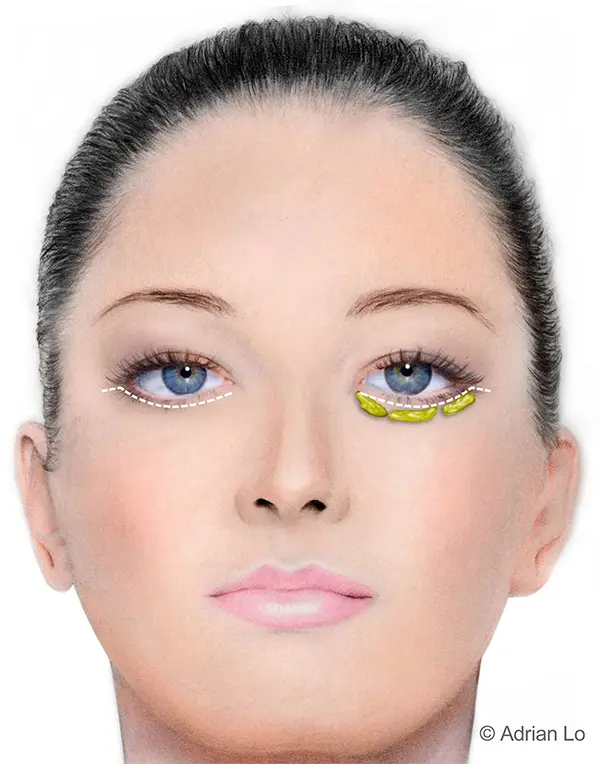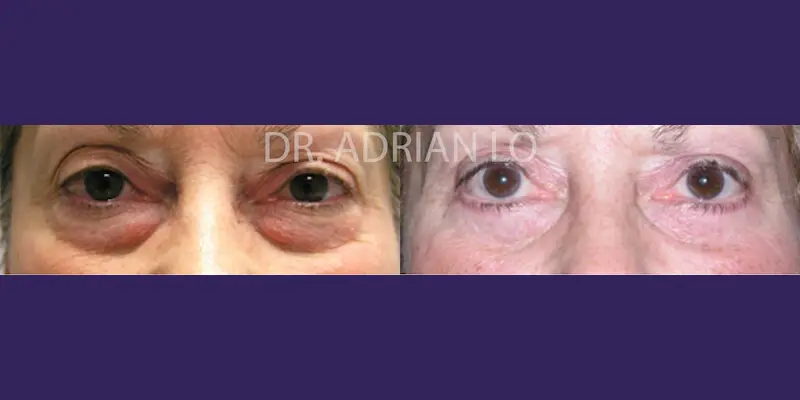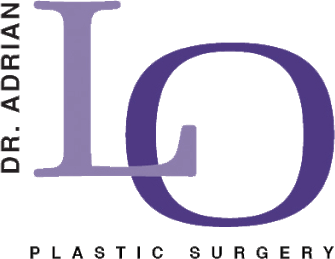Persistent under-eye puffiness affects not only appearance but also confidence for many individuals.
Under-eye puffiness can create a tired, aged appearance that does not reflect how a person feels or their actual age.
While temporary treatments may offer minor improvement, long-term results require an understanding of the anatomical causes and the treatment options that can address them.
Modern plastic surgery techniques make it possible to significantly improve the appearance of under-eye bags—and, in many cases, remove them permanently giving you a refreshed and younger look!
Patients exploring how to remove eye bags permanently should first consider if their puffiness is due to fat bulges, fluid retention, skin laxity or a combination of all three.
Related: Upper vs Lower Blepharoplasty: Which Eye Procedure Do You Need?
Why Eye Bags Form and Persist Over Time

There are many causes of eye bags including genetics, fat pads causing bulges, fluid retention, and skin laxity or loose skin.
Over time, the fat pads beneath the eyes can shift forward, creating bulges. Simultaneously, the surrounding skin may lose firmness, contributing to the puffy, shadowed look.
Fat Accumulation Under the Eyes
One of the primary causes of eye bags is the protrusion of orbital fat. The globe or eyeball normally sits on a pad of fat, which acts as a cushion. There is a membrane called the septum that holds the fat in place. With age, the septum weakens and the fat begins to protrude out and form visible bulges or bags in the lower eyelid area.
Some patients have fat bags or bulges at a very young age because their septum that holds the fat back is weaker. These patients are thought to have a genetic predisposition to fat bags.
Skin Laxity from Aging
Aging and sun damage causes the skin to lose elasticity due to a reduction in collagen and elastin. The skin around the eyes begins to bunch up contributing to the puffy look in the lower eyelid area.
Fluid Retention and Lifestyle Triggers
Diet, sleep habits, and allergies can contribute to swelling under the eyes due to fluid retention.
High sodium intake, irregular sleep patterns, and sinus congestion can cause temporary puffiness that eventually becomes persistent.
Daily Habits That Worsen Under Eye Puffiness
Some everyday behaviors can worsen eye bags over time.
Addressing these factors early may help reduce mild puffiness and prevent the need for more aggressive intervention.
Non-invasive methods may provide short-term improvements, but those looking for how to remove eye bags permanently should understand their anatomical causes.
High Sodium Diet and Water Retention
Excess sodium causes the body to retain fluid, which can accumulate under the eyes. A low-sodium diet combined with proper hydration supports healthier skin and reduces visible swelling.
Inconsistent Sleep Patterns
Lack of sleep or an irregular sleep schedule can increase under-eye puffiness and discoloration. Establishing a consistent sleep routine supports skin health and lymphatic drainage.
Rubbing the Eyes or Allergies
Frequent eye rubbing, often due to allergies, can stretch the skin and inflame surrounding tissues. This mechanical irritation contributes to long-term skin laxity and visible puffiness.
What is the Best Treatment for Under Eye Bags?
The best treatment for under eye puffiness depends on what is causing the concern — fluid retention, skin laxity, or fat bulges. Continue reading below to learn about the different treatment options for under eye bags, their effectiveness and if the treatment is permanent.
Over-the-Counter Remedies for Mild Puffiness
For individuals with mild swelling or temporary puffiness, non-prescription treatments may provide some relief. These are best suited for cases without significant fat bulges or skin laxity.
While many creams offer superficial benefits, they do not provide a reliable solution for those seeking how to remove eye bags permanently.
Caffeine-Infused Eye Creams
Caffeine constricts blood vessels and helps reduce swelling. Eye creams with caffeine can offer temporary improvement, particularly when applied in the morning.
Cold Compress Therapy
Cold temperatures reduce inflammation and constrict blood vessels. Using chilled gel masks or cold spoons may help minimize under-eye puffiness.
Topical Peptides and Antioxidants
Ingredients like peptides, vitamin C, and green tea extract can support skin health and reduce signs of fatigue. These treatments improve skin texture but do not remove fat pads or tighten loose skin.
Non-Surgical Eye Bag Reduction Options
For patients with early signs of puffiness, understanding how to remove eye bags permanently often starts with non-surgical procedures.
Non surgical eye bag removal options such as fillers and radiofrequency treatments may work well for patients with mild puffiness and good skin elasticity. The results of fillers and radiofrequency treatments can last from 6 months to 1 year.
Dermal Fillers for Tear Trough Volume
Injectable fillers can smooth the transition between the lower eyelid and the cheek. By adding volume below the eye bag, fillers reduce the appearance of shadowing and hollowing.
Laser Resurfacing Around the Lower Eyelid
Fractional laser treatments stimulate collagen and tighten the skin. This can improve skin texture and reduces fine lines around the lower eyelid, especially when skin laxity is mild.
Radiofrequency or Ultrasound Treatments
These energy-based technologies use heat or ultrasound, such as Sofwave™, to stimulate collagen production. They can modestly tighten the skin. Results are gradual, as it is based upon the body producing collagen and can take up to 8 to 12 weeks before seeing results.
Understanding Lower Eyelid Surgery (Blepharoplasty)
Patients often ask how to remove eye bags permanently when other treatments no longer provide noticeable results.
Lower eyelid surgery for eye bags remains the gold standard when addressing significant fat bulging and loose skin that other treatments cannot resolve. Lower eyelid surgery is also called lower lid blepharoplasty or lower eyelid tuck.
For patients seeking how to remove eye bags permanently, lower eyelid surgery is often the most effective solution. It addresses the underlying anatomical causes of puffiness, including fat protrusion and excess skin.
Incision Placement and Healing
Incisions are typically placed inside the lower eyelid (transconjunctival) or on the skin just below the lash line (subciliary). Both techniques heal well, with minimal visible scars when performed by a qualified plastic surgeon.

Fat Removal
Through the cut or incision, the bulging fat is removed and sculpted very carefully to give a smooth look to the lower eyelid area. In the lower eyelid area there are three fat pads or pockets that need to be contoured to give you the desired smooth look.
Skin Removal
Depending on the extent of skin laxity, a small amount of skin may be removed during surgery. In some cases, lower eyelid tightening is performed to support the eyelid and reduce sagging.
Who Is a Good Candidate for Eyelid Surgery
Ideal candidates are healthy individuals with realistic expectations. The best outcomes are typically achieved when puffiness is caused by fat bulges rather than fluid retention alone.
Assessing Skin Elasticity and Fat Pads
A consultation will evaluate your lower eyelid to assess the degree of skin laxity, fat bulges, and the presence of tear trough hollowing. The overall tone or support of your lower eyelid will be assessed.
With this assessment, surgery or non-surgical options will be recommended.
General Health Requirements
Patients must be in good stable health and not actively using nicotine products. Smoking interferes with blood circulation resulting in an increased risk of healing issues. Proper healing requires optimal circulation and tissue integrity. Patients will be required to stop smoking at least 2 weeks prior to surgery and at least 2 weeks after during the post-operative healing phase.
Common Patient Goals for Eye Appearance
Many patients seek a smoother, more rested appearance without changing the natural shape of their eyes. Eyelid surgery can accomplish this with careful customization.
Selecting the right cosmetic procedure for eye bags requires professional evaluation to determine if surgery or a less invasive method is most appropriate.
Comparing Fillers vs. Surgery for Eye Bag Removal
While fillers offer temporary enhancement, surgery provides permanent structural correction. Each approach has advantages depending on the patient’s anatomy and goals.
While lower lid eyelid tuck or blepharoplasty may be more expensive initially, it does give a permanent solution to eye bags.
Eye bag removal cost varies depending on the technique used, the complexity of the case, and the geographic location of your plastic surgeon.
Longevity of Results Between Options
The decision between under eye filler vs surgery should be based on how much correction is needed, how severe the fat bulges are and how long the patient wants the results to last.
Fillers correct any existing hollowing and camouflages the fat bulges but does not remove or correct the fat bulges. Fillers are best for minor fat bulges. More severe fat bags will likely need lower lid blepharoplasty to correct the situation.
Fillers typically last 6 to 12 months, while surgical results can last for a decade or longer. Those seeking long-term improvement often prefer surgery.
Downtime and Recovery Differences
Non-surgical options have minimal downtime but require regular treatment to maintain the results. Surgery involves a recovery period of approximately one to two weeks, with bruising and swelling that gradually resolve.
Suitability for Different Age Groups
Younger patients with early signs of aging may benefit from fillers or laser therapy. Older patients or those with significant puffiness are more likely to need surgical correction.
A plastic surgeon can assess which approach is best for how to remove eye bags permanently, depending on your age, anatomy, and goals.
What to Expect During Blepharoplasty Recovery

Healing from eyelid surgery is typically straightforward when proper aftercare is followed. Most patients return to work and regular activity within two weeks.
Eye bag removal recovery time is typically short, with most patients resuming work and daily routines within one to two weeks.
Bruising and Swelling Timeline
Keeping your head elevated at 45 degrees and ice compresses are used during the first 48 hours postoperatively to reduce swelling and bruising. Staying calm and keeping your blood pressure normal helps as well.
Bruising peaks around day three and fades within ten days. Swelling may take several weeks to fully subside as the lower eyelid skin is very delicate.
Care for the Surgical Incision Site
Patients are advised to keep the area clean, avoid rubbing, and use eye drops as necessary. Moistened cotton applicators can be used to keep the incision clean.
Resuming Work and Daily Activities
Light activities may resume within five days, while full physical activity should be avoided for two to three weeks. Most patients feel comfortable returning to public settings within ten days.
If you want to know how to remove eye bags permanently, a consultation with a board certified plastic surgeon will allow you to determine if you are a good candidate for a lower eyelid tuck.
Long-Term Results of Eye Bag Removal Procedures
When performed correctly, lower eyelid surgery provides lasting results that align with the patient’s natural features. Reoperation is not common and revision is rarely necessary.
Maintaining Results with Skin Care and SPF
Proper sun protection and skincare help prolong the effects of surgery. Hydration, retinoids, and antioxidant creams are often recommended.
Lifestyle Adjustments to Prevent Recurrence
Managing allergies, avoiding excessive salt, and establishing a healthy sleep pattern can support long-term results and reduce swelling.
Aging Considerations Over Time
Although surgery removes existing puffiness, aging continues. Some patients choose to refresh their results with non-surgical treatments years later.
Risks Associated with Eye Bag Removal Treatments
While lower eyelid surgery is generally safe, all procedures carry risks. Choosing a board-certified plastic surgeon reduces the likelihood of complications. There are the usual surgery risks such as bleeding, infection and numbness.
Incision or Scar
As mentioned, the subciliary incision usually heals well and the scar is barely visible. The transconjunctival incision heals inside the lower eyelid and is not seen.
Temporary Dryness or Irritation
Some patients experience dry eyes or irritation during the first few weeks. Artificial tears and ointments help ease this discomfort.
Risk of Asymmetry or Irregular Healing
Asymmetry, slight differences between the left and right lower eyelid, is normal. Follow-up visits allow the plastic surgeon to monitor healing and make recommendations if necessary.
Managing Expectations for Final Outcome
Understanding the limits of each surgical technique helps patients remain satisfied with their outcome. Natural-looking results are prioritized to preserve facial harmony and avoid an overcorrected appearance. Of importance, is when lower eyelid tuck is done correctly, the shape of your eye remains the same and there is no change in your facial features aside from looking younger and refreshed.
Speaking with a board-certified plastic surgeon is essential when deciding how to remove eye bags permanently and ensure a natural result.
Consult Dr. Adrian Lo for Permanent Eye Bag Removal Options
If under-eye puffiness is affecting your appearance or confidence, there are effective options available.
Plastic surgery for under-eye bags offers a more permanent solution for individuals whose puffiness is caused by fat pads and excess skin.
Dr. Adrian Lo offers both surgical and non-surgical solutions to address your specific concerns. Serving patients throughout Pennsylvania, New Jersey, and Delaware, Dr. Lo provides individualized treatment plans focused on safety, results, and long-term satisfaction.
For expert guidance on how to remove eye bags permanently using a customized approach based on your unique facial structure, contact us today.
